A team of archaeologists has unearthed bones of reindeer and woolly mammoth in the limestone cave hidden beneath Pembroke Castle.

The castle stands on a site that has been occupied at least since the Roman period, and is one of Wales’ finest ancient landmarks. Many believe this impressive stucture of the ancient worlds could keep secrets dating back to the Stone Age.
Wogan Cavern – the place of the recent archaeological discovery – is set to be dug up by a team of archaeologists who are hoping to uncover fresh evidence of how the cave was used by humans and Ice Age animals thousands of years ago, writes WalesOnline.
The archaeologists led by Dr Rob Dinnis of the University of Aberdeen and Dr Jenni French of the University of Liverpool, started their work at the end of June, and the goal is to uncover parts of the cave that have still remained undisturbed for more than 10,000 years.
Preliminary works were already carried out in summer 2021 after Dr Dinnis and John Boulton, of the Devon Spelæological Society, suspected that some valuable clues of early human civilisation could be hidden under the layers of earth beneath the Pembroke Castle. Their suspicions proved correct when they discovered bones of reindeer and woolly mammoth showing it was likely an important place for the Mesolithic period.

Pembroke Castle has a long and fascinating history. It withstood a long siege by the Welsh, although its defenders were near starvation. The late 12th century keep is both an outstanding feature and architectural novelty, because this ancient structureit has a massive cylindrical tower with an unusual stone dome.
Pembroke’s strategic placement on the Milford Haven waterway made the castle the main departure point to Ireland and saw both Henry II and King John pass through its doors en route. The easy access by boat to the mouth of the cave also made it the perfect storeroom and possible boathouse during the Middle Ages. During the 13th century the Wogan was incorporated into the castle’s defences with a large watergate being built across the mouth of the cavern.

The upcoming works of the reserachers involved in the excavation, will hopefully uncover evidence for even older human occupation dating to the Palaeolithic period (before 12,000 years ago).
“We are incredibly excited about this year’s excavation. Prior to our work next to nothing was known about the archaeology of Wogan Cavern,” Dr Dinnis said.
”It has long been assumed that the cave was dug out either during the medieval period when it formed part of the castle or during the very poorly-recorded Victorian antiquarian digs. Our work shows that is not the case. Instead it is now clear that the cave has real potential as an early prehistoric site.”

Whilst the castle will remain open to visitors during the three weeks Wogan Cavern itself will be mostly closed to the public although the Castle will be arranging some scheduled information sessions so that castle visitors can meet some of the excavation team and learn about the progress of the dig.
The works are funded by the Natural History Museum and the British Cave Research Association.

A team of archaeologists has unearthed bones of reindeer and woolly mammoth in the limestone cave hidden beneath Pembroke Castle. The castle stands on a site that has been occupied at least since the Roman period, and is one of Wales’ finest ancient landmarks. Many believe this impressive stucture of the ancient worlds could keep
Source: favgalaxy








